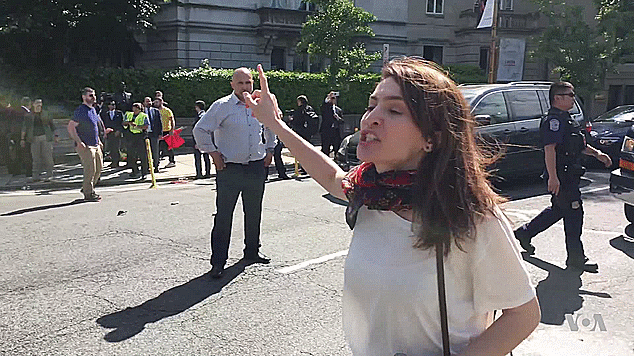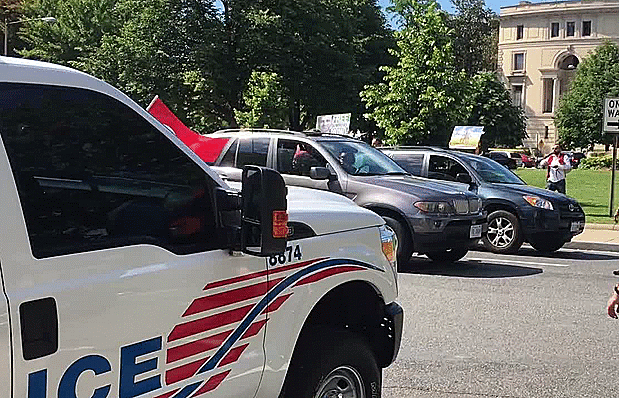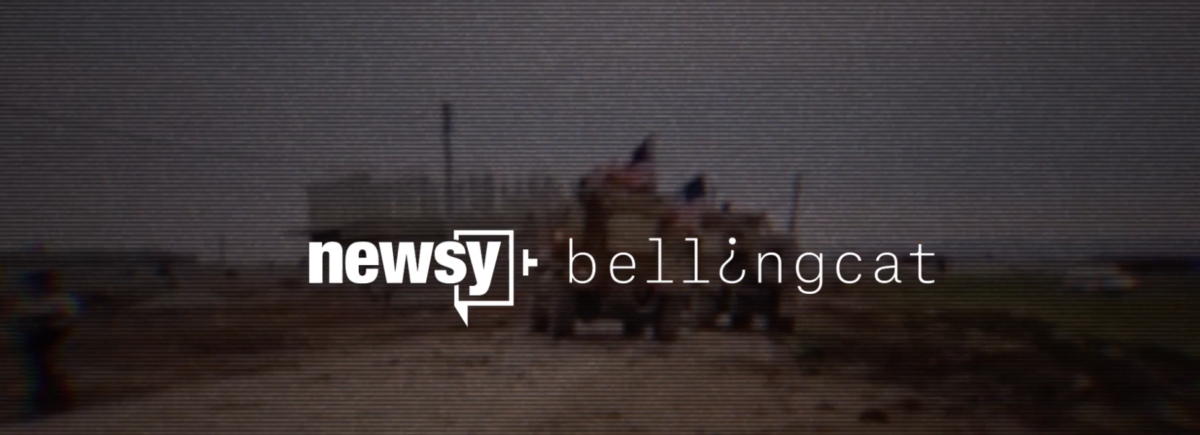Yaz Gazeteci Yaz - Fact Checking Anadolu Agency's Take on the "Erdoğan Bodyguard Attack"
Introduction
On May 20, 2017, Turkish state-owned news agency Anadolu Agency (AA) published a video on their English language Twitter channel called “What really happened outside Turkey’s US Embassy?”.
[Video] What really happened outside Turkey’s US Embassy? https://t.co/7aEc2TVni3 pic.twitter.com/FWM4QSmEoS
— ANADOLU AGENCY (ENG) (@anadoluagency) May 20, 2017
The topic of the video is the violent events around the Turkish ambassadors’ residence [38.911580, -77.050789] on May 16, 2017 (for some background information, see e.g. the Bellingcat article “Online Campaign to Identify “Erdoğan’s Bodyguards” Following Assault”).
In the video, AA largely blames the pro-Kurdish/anti-Erdoğan protesters for the outbreak of the violence and presents the involvement of the Turkish security officials in the brawl as necessary action: “Seeing how few US police officers were acting against the riot of the PKK/PYD supporters, a group including the president’s security detail and the Turkish police stepped in” (2:14). With this statement AA confirms the involvement of Turkish security officials in the fighting, a fact that was already widely considered as confirmed.
A written report accompanies the video with a longer description of the events. The report is written by Safvan Allahverdi, who states that he was an eyewitness of the events and therefore has first-hand knowledge from the incident. A comparison between the video and the report reveals that while the general tone is similar, the report recalls the events in more detail and also uses a slightly different wording from time to time. In particular, the second brawl after Erdoğan’s arrival is described with the following words: “When Erdogan arrived at the embassy building, protesters continued their grave insults, so some Turkish citizens and the head of the president’s security detail stepped in.” The claim from the video that there was a “riot of the PKK/PYD supporters” is thus missing in the description of the events.
However, the presented course of events in the AA video and report appears to be different from other stories of the incident. In the video the implied reasoning behind the involvement of Turkish security officials also contradicts the so far assumed responsibilities. This either suggest that the AA video and report presents new evidence, the available evidence was misinterpreted until now, or that AA presents a misrepresentation of the events.
The intention of this post is to present the main claims made by AA in the video and analyze their veracity. Additionally, the written report is considered where necessary. The analysis is not limited to the wording and the literal meaning of statements made but also their meaning giving the context of the statements within the video. Only video documents from the events are used, other possible source, e.g. interviews are not considered. While this article does touch some sensible topics related to the events on May 16, it is not an investigation of the events itself, the scope is strictly limited to the aspects raised by the AA video and report. If quotes stem from the video, the exact second is stated, if a quote stems from the written report, (report) is used as reference to the source.
Before the Violence
The written AA report starts with the description of events near the White House at Lafayette Square preceding the clashes near the Turkish ambassadors’ residence. Two groups of protesters, one group supportive of Erdoğan and one pro-Kurdish/pro-Armenian/anti-Erdoğan group had been present in the area. The police and US security officials separated both groups. While both groups are described as shouting slogans, there was no reported violence between them. These events are not covered in the AA video.
The AA video covers the events which happened near the Turkish ambassadors’ residence, a building 700m south-east of the Turkish embassy. At the beginning of the video (0:06–0:20), two groups of demonstrators are shown. One group supportive of Erdoğan, and a second group introduced by AA as “PKK/PYD terrorist group supporters”. Later in the video, AA states that “Across from the group [of pro-Kurdish/anti-Erdoğan protesters], there are Turkish citizens” (0:46). Again the larger group supportive of Erdoğan is shown, this time shortly after the pro-Kurdish/anti-Erdoğan protesters. The video therefore introduces two opposing groups of demonstrators, and it is strongly implied that these two groups opposed each other at the beginning of the violence on May 16.

left: pro-Erdoğan demonstrators near the Turkish ambassadors’ residence as depicted in the AA video (0:46), right: Google street view imagery from the residence (August 2011)
In the report the initial situation is described similar: “While shouting anti-Erdogan slogans, the group started to swear and insult Turks, who were just across the road. Turkish citizens responded with their own slogans.” (report) Furthermore, it is stated that “The PKK supporters made a great effort to make Turkish citizens lose control through their insults and swearing. We saw that the Turkish group was provoked by PKK sympathizers moving into the middle of the road with megaphones.” (report)
However, available imagery reveals that the sequence showing the pro-Kurdish/anti-Erdoğan protesters presented in the video was filmed after the first and initial brawl, while the group of Erdoğan supporters shown in the AA video were not present at the time of the first clash. While a group of Erdoğan supporters holding Turkish flags can be seen arriving during the begin of the first brawl, it does not appear to be the same group featured in the AA video. It can be stated with certainty, that the video sequences of the two opposing groups presented in the AA video were made not at the same time, all videos showing the violent clashes do not show the depicted large pro-Erdoğan group. The AA video therefore misrepresents the initial situation preceding the clashes.
A known video from the events starting some seconds before the first clash between the two sides occurred further documents that initially almost only persons equipped with what appear to be earplugs and guns, leading some to suggest they were ‘Turkish security officials’, were present. The ‘Turkish security officials’ opposed the pro-Kurdish/anti-Erdoğan protesters, and only some seconds before the first brawl started, an all-male group of pro-Erdoğan demonstrators in civilian clothes moved towards them. While it is therefore difficult with the available imagery to assess the veracity of the described situation in the written account before the violence broke out, the presence of mainly ‘Turkish security officials’ at that time suggests that the written account might be a misleading description. And while shortly before the first clash occurred there was in fact a stand-off between the two groups in the middle of the street, the claim about “insults and swearing” prior to the clash cannot be verified with the known videos.

Situation shortly before the first documented clash, left of the police car is a group of pro-Kurdish/anti-Erdoğan protesters opposed by ‘Turkish security officials’, right of the police car are pro-Erdoğan demonstrators in civilian clothes moving towards these persons
Also, the general and repeated labeling of the pro-Kurdish/anti-Erdoğan protesters as “PKK/PYD terrorist group supporters” can be considered as misleading and politicized and emotional loaded usage of language. In the AA video it is stated that “They carry the symbols of the terrorist organization responsible for the massacre of thousands of innocents in Turkey” (0:35). The video shows a man holding the “Alaya Rengîn” (The Colourful Flag), symbol for the Kurds’ desire for independence at this time. It is not clear where exactly this man was filmed, but he is not visible in the group of pro-Kurdish/anti-Erdoğan protesters during either the first or second clash. However, he was earlier filmed in the preceding Lafayette Square protest.
Afterward, the video again shows the group of protesters and zooms on a YPG flag. Other imagery shows that also a flag of Rojava (also used by the PYD) is present. The written AA report lists “posters of Abdullah Ocalan, […] as well as jailed Peoples’ Democratic Party (HDP) head Selahattin Demirtas, and flags of the YPG, the armed Syrian offshoot of the PKK/PYD.” (report)

Stills from the AA video showing the presented flags while claimed the symbols of terrorist organizations were carried, left: “Alaya Rengîn” (The Colourful Flag) (0:36), right: YPG flag (0:40)
So while there were evidently YPG, Rojava and also Kurdistan flags present, as well as imagery depicting Selahattin Demirtaş, these symbols are not sufficient for the classification made by AA. It is likely there is a relationship between the Syrian PYD/YPG and the Turkish PKK, however, the legal characterization of this two groups strongly differs in the US. While the PKK is considered as a “Foreign Terrorist Organization”, the same does not apply to the YPG, the militia of the PYD. Therefore, equalizing both groups might be valid from the “Turkish” point of view, but it is not valid from a US point of view, the place of protest. Moreover, AA fails to present clear evidence for at least one claim made, it presents no imagery showing a poster with Abdullah Öcalan.
After both groups are introduced in the AA video, the unfolding events are presented. “The terror slogans of the PKK/PYD supporters turn into abusive and insulting acts towards Turkish citizens” (0:54). Shown is a woman shouting towards the camera and throwing water from a bottle in the direction of the pro-Erdoğan demonstrators. The sequence stops the moment the woman makes a movement similar to throwing the bottle towards the pro-Erdoğan demonstrators. From the AA video it is not clear if the bottle was thrown or not.

left: AA video showing the woman throwing water towards the pro-Erdoğan demonstrators after the first clash, right: another video showing the scene some seconds later, visible is the camera of the AA team, the pro-Erdoğan demonstrators (mainly: ‘Turkish security officials’ at this time), police offices trying to separate the groups and the landed water bottle on the street
This sequence was however in fact filmed shortly after the first violent clash and therefore did not precede the events. While the bottle is thrown by the woman, it does not even reach the other side of the street and lands far away from the demonstrators. A comparison between the before by AA presented group of pro-Erdoğan demonstrators and the present group in this phase again documents the misleading usage of imagery by AA.

Full sequence showing the woman shouting the the AA camera man and throwing water and the empty bottle in the direction of the ‘Turkish security officials’, note the absence of the large group of pro-Erdoğan demonstrators presented in the AA video]
The next sequence in the AA video states that “Turkish citizens respond verbally and chant slogans supporting Turkey” (1:02). Again, the large group of pro-Erdoğan demonstrators already shown earlier in the AA video is shown. This statement is misleading in two ways. First, as previously explained, the sequence presented as a provocative act before the violence started was filmed after the first violent clash. Also, the above image documents that even after the first violent clash most of the present pro-Erdoğan demonstrators were still ‘Turkish security officials’ and the group of civilian Erdoğan supporters waving Turkish flags shown in the AA video was not present at this time. Moreover, while seemly pro-Turkish slogans were chanted between the first and the second brawl, these slogans were mainly sung by ‘security officials’.
Given the similarity between the written account – “While shouting anti-Erdogan slogans, the group started to swear and insult Turks, who were just across the road. Turkish citizens responded with their own slogans.” (report) – and the story told in the AA video, and the fact that the AA video can be considered as supporting material of the written account, these clear discrepancies in the video cast further doubt on the description of the situation before the violence broke out in the written account.
First Blood
The following sequence in the video allegedly shows the first violence between the groups: a pro-Kurdish/anti-Erdoğan protester throws a bottle at a pro-Erdoğan demonstrators. The accompanying text states:
“Trying to start a fight, PKK/PYD supporters initiate attack” (1:09)
In the report it is stated that
“The first fight broke out when supporters of the terrorist group threw water bottles at Turkish citizens, triggering a 10-15 second fistfight in the middle of the road.” (report)
Again, it is a misleading usage of imagery by AA and also quite likely a misleading presentation of the situation.
The shown event happened and the bottle was thrown at and hit the head of a pro-Erdoğan demonstrator, however, this attack occurred at the end of the first violent clash, approximately 15 seconds after the first documented acts of violence. The present police already worked hard to separate both groups, with three police officers visible in the AA video. Moreover, in the video showing the seconds before the first brawl started, there are no flying bottles visible, so a thrown bottle cannot be confirmed as the cause for the first brawl. However, at least one bottle laid already on the “Turkish” side of the street close to the sidewalk at the beginning of the first brawl.
The exact starting point and reason of the first clash cannot be derived from the available imagery. Shortly before the group of pro-Erdoğan demonstrators in civilian clothes reaches the ‘Turkish security officials’ opposing the pro-Kurdish/anti-Erdoğan protesters on the street, it is visible that one female pro-Kurdish/anti-Erdoğan protesters falls after being pushed by a ‘Turkish security official’ and a pro-Kurdish/anti-Erdoğan protesters tries to use a megaphone as weapon, but seemly misses his target with this blow. While these events are clearly visible, it is not possible to see who initiated or what caused the violence.

Start of the first clash, left: usage of megaphone as weapons and attack on female pro-Kurdish/anti-Erdoğan protester, right: female protester on the ground, pro-Erdoğan demonstrators in civilian clothes join the brawl
In the course of the first clash, one of the pro-Erdoğan demonstrators wearing a yellow shirt, presented as Turkish citizen Alp Kenan Dereci by AA, was hit by a megaphone. This event is recalled by AA:
“During these attacks, Turkish citizen Alp Kenan Dereci was seriously injured” (1:12)
and
“An ambulance arriving at the scene was the first responder to Dereci, who was injured when a PKK/PYD supporter hit him in the head with a megaphone. Dereci was later taken to the hospital” (1:28).
In the report it is stated that
“Also stepping into the fight, a Turkish citizen named Alp Kenan Dereci was severely injured when a PKK supporter hit him in the head with a megaphone.” (report)
In this case, the main statement that he was hit by a pro-Kurdish/anti-Erdoğan protester with a megaphone is true. However, in the AA video only half of the story is told, while the written report is closer to the course of events. The moment the violence starts between the pro-Kurdish/anti-Erdoğan protesters and the ‘Turkish security officials’, Dereci willingly joins the fight without being attacked himself. He is later hit at the head with the megaphone while attacking an isolated pro-Kurdish/anti-Erdoğan protester himself with his fists.

Events leading to the injury of Alp Kenan Dereci, he attacks a pro-Kurdish/anti-Erdoğan protester with blue shirt with his fists, while attacking this protester he is hit by the megaphone
AA states further in the video that
“During the entire attack, only 2 police officers interceded” (1:41)
In the report a slightly different wording is used and it is stated that
“Only two police officers interceded in the fight, and it was clear the police were not ready for such a scene. Besides, there were only around 10 police officers outside the embassy.” (report)
The video sequence accompanying the statement however already shows at least six – and quite likely seven – police officers. Furthermore, already five officers are visible actively trying to disengage the groups in the video showing the first clash – the moment the AA statement quite likely shall refer to. The officers partly do this neglecting their own security. Therefore, the statement made by AA in the video is a misrepresentation of the general situation.

Still from the AA video (1:44), left: original image, right: present police officers marked, note: this sequence was filmed after the first brawl
Following the first violent clash between the two groups and the injury of Dereci, the police present tries to keep both groups disengaged to prevent further violence. AA states in this context that
“After the attacks, Turkish citizen explained to the police that they had actually seen an assault and they saw who did it, and that the attacker should be immediately taken into custody” (1:54)
and
“But the police did not detain him, and also asked the Turkish citizens to step back and calm down” (1:57)
In the written report the situation is described in a similar manner.
A video showing the aftermath of the first violent clash in more detail shows the police actively trying to keep both groups disengaged and clear the street for the traffic. Police officers have to appeal to both sides to disengage and stay on “their” side of the street on the sidewalks. While eventually the pro-Kurdish/anti-Erdoğan protesters largely comply, the police still must actively ensure that the pro-Erdoğan demonstrators, including ‘Turkish security officials’, do not enter and cross the street. The same is visible in the AA video, the ‘Turkish security officials’ are standing not on the sidewalk and the “calm down” from the police officer is meant to bring the situation back under their control. While AA implied that the police did not want to act and deal with the potential suspect, the police acted, but was limited by the still ongoing situation.
Erdoğan’s Arrival
The last part of the AA video covers the second and larger brawl. The violence started after Erdoğan arrived at the scene but before he has left the car. AA states that
“With the arrival of President Erdogan [sic!], the terrorist group supporters escalated their barrage of curses” (2:05)
The written report also describes the situation:
“With no obstacles to block them, the terrorist group backers got very close to the Turkey supporters and shouted slogans and threw water bottles.” (report),
“The PKK supporters, who kept a greater distance during Erdogan’s [sic!] White House visit, outside the embassy were able to get within 15-20 meters of him.”(report),
and
“Due to the fanaticism of the terrorist group, we were also worried about our own safety.” (report)
The video showing the start of the second brawl shows police motorbikes forming a blockade in front of the pro-Erdoğan demonstrators, and the police still actively trying to keep both groups disengaged, with almost all police officers occupied by the pro-Erdoğan demonstrators. The pro-Kurdish/anti-Erdoğan protesters are standing on the sidewalk and shouted their slogans. The distance between them and Erdoğan’s’ car was around 30m – as measured in Google Earth, and there was only a limited direct line of sight between them and his car, as documented by the video showing the second brawl from behind his car. So while after Erdoğan arrived at the scene, the pro-Kurdish/anti-Erdoğan protesters – understandably – intensified their verbal protest, there was no documented active violence between the groups. The situation might be uncomfortable for the Turkish president, however, a direct threat to him cannot be identified. Erdoğan also did not leave the car at this time of the events; he stayed in the car and seemly talked with one of his security officials.
The start of the violent second clash is described slightly differently in the two AA accounts. In the video it is stated that
“Seeing how few US police officers were acting against the riot of the PKK/PYD supporters, a group including the president’s security detail and the Turkish police stepped in” (2:14).
In the written report it is stated that
“When Erdogan arrived at the embassy building, protesters continued their grave insults, so some Turkish citizens and the head of the president’s security detail stepped in.” (report)
The written reports lacks, as mentioned earlier, the reference to a riot which seemly is stated as reason for the involvement of the Turkish security officials in the brawl in the video. Furthermore, the second brawl was almost certainly started by a Turkish security official. The video depicting the beginning of the violence shows a man running across the street and attacking a pro-Kurdish/anti-Erdoğan protesters. It is a protester wearing a blue shirt. He was already involved in the first brawl and was the man who was attacked by Dereci. It is noteworthy that this protester is seemly later detained by the police.
It is visible that the man running across the street wears a gun and an earbud, as visible by the cable. As he runs across the road it appears protesters on both sides are not engaged in any violence, nor does anyone appear to be reacting to any violence until he is about the reach the pro-Kurdish/anti-Erdoğan protesters. Because there is no violent activities visible before he attacked the protesters, it is quite likely that he has initiated the second round of violence. Other ‘Turkish security officials’ and what appear to be civilians join him shortly afterward and also start to attack the protesters, including kicking defenseless protesters already on the ground. Erdoğan leaves his car and enters the ambassadors home only after the pro-Kurdish/anti-Erdoğan protesters were silenced by the attack.

Man suspected of starting the second brawl, left: running across the street, the gun is visible, center and right: attacking a pro-Kurdish/anti-Erdoğan protesters, in the center image the earbud and cable are visible
Summary
A video and a report published by the Turkish state-owned Anadolu Agency (AA) presents an alternative course of events for May 16, 2017. This article analyses both the visual evidence and the written account. In the described course of events in both accounts, AA largely blames the pro-Kurdish/anti-Erdoğan protesters for the violence. However, a closer look at the presented imagery and the statements made in the video and the report reveals that some claims made by AA are wrong, others are misleading in the given context and some are not supported by facts.
AA uses the available videos from the events in a quite creative manner. Imagery is repeatedly used out of context, wrongly attributed in the order of events or even presented under a false premise. In particular, a video sequences filmed after the first clash occurred is presented by AA in a way that strongly suggest that the video precedes the violence. Another sequence filmed in the course of the first clash is presented in a way that suggest that this action was the reason for the violence. While these events happened on May 16, they appear deliberately misrepresented by AA to tell their story of that day.
Other statements are not-well founded or would need an extremely strict definition to be considered as valid. This encompasses the description of the pro-Kurdish/anti-Erdoğan protesters as “PKK/PYD terrorist group supporters”, as well as the suggested absence of the police. However, there is a notable difference between the written account and the video. In the video the statements are strongly misleading, while in written report the statements are closer to the truth in these two cases and can be characterized as “only” misleading. Other statement made in the video are seemly invented, like the given reason for the participation of Turkish security officials in the second brawl.
Even given this issues, most statements made in the video and the report alone could be still – while problematic – assessed on its own as somehow acceptable. However, while this holds for most statements alone, the story told by AA as a whole can only be considered as blatant and deliberate twisting and distorting of the facts.
With thanks to the Atlantic Council’s Digital Forensic Research Lab for assistance with this article.


